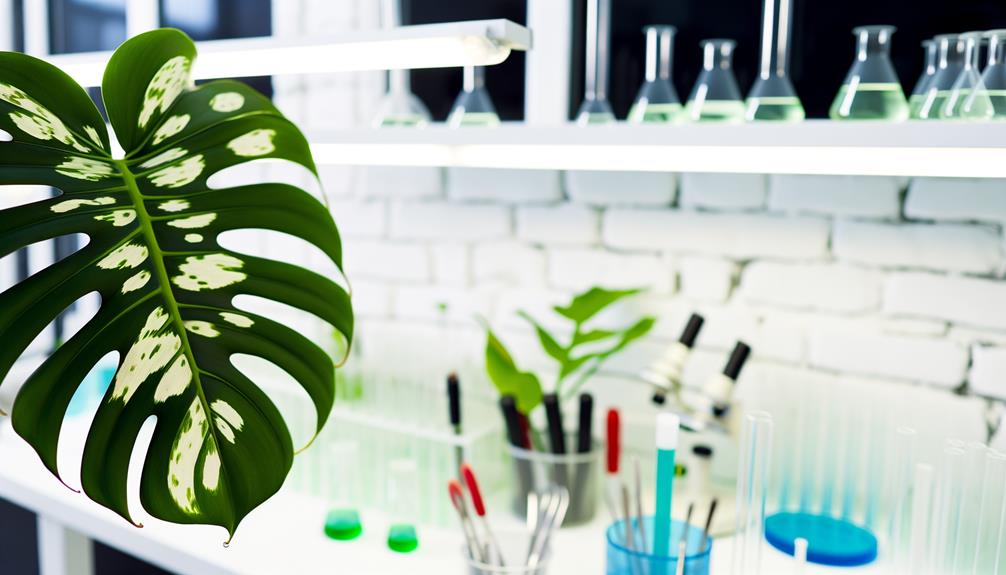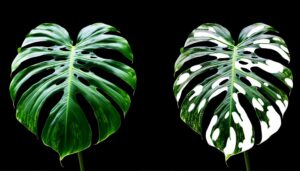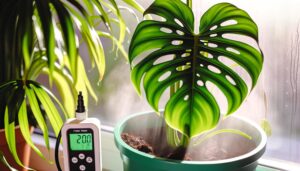Can You Tissue Culture Monstera Albo? Yes!
You can tissue culture Monstera Albo by starting with a small sterilized plant tissue piece in a nutrient-rich medium. Ensure a sterile environment and balance growth hormones for best development.
This process requires maintaining precise temperature, light, and humidity conditions. Monstera Albo’s variegation, caused by a genetic mutation, needs close monitoring to manage varied patterns and reduced photosynthesis.
Expect challenges like contamination, hormonal imbalance, and genetic stability concerns. Using sterilized equipment and maintaining a rigorous sterilization routine are essential.
Detailed steps and expert tips can help achieve success with this intricate propagation method. Discover more specifics to master this technique.

Key Takeaways
- Yes, Monstera Albo can be tissue cultured using sterile techniques and controlled environments.
- Requires precise hormonal balance, particularly auxins and cytokinins, to manage growth and variegation.
- Essential equipment includes a laminar flow hood, sterilized tools, and nutrient-rich growth medium.
- Challenges include maintaining genetic stability and managing contamination risks.
- Success depends on rigorous sterilization, controlled light, temperature, and balanced nutrients.
What Is Tissue Culture?
Tissue culture is a precise method where you propagate plants by cultivating cells or tissues in a controlled, sterile environment. In this process, you begin with a small piece of plant tissue, known as an explant.
You then place the explant in a nutrient-rich medium that contains essential vitamins, hormones, and minerals. The medium supports cell division and differentiation. By maintaining aseptic conditions, you prevent contamination from bacteria and fungi. The environment’s temperature, light, and humidity are meticulously regulated to optimize growth.
Over time, the explant will develop into a callus, and eventually, into a plantlet. This method allows you to produce multiple, genetically identical plants from a single specimen, ensuring uniformity and quality.
Benefits of Tissue Culture
By using tissue culture, you guarantee consistent plant quality, as each Monstera Albo produced is genetically identical to the original.
This method also promotes disease-free propagation because the sterile environment minimizes the risk of contamination.
You’ll achieve healthier plants with uniform traits, enhancing both aesthetic appeal and resilience.
Consistent Plant Quality
One of the primary benefits of using tissue culture for Monstera Albo is the ability to produce plants with uniform quality, guaranteeing each specimen displays the same desirable traits. This consistency is essential for serious collectors and commercial growers alike. By selecting tissue culture, you can achieve:
- Uniform Growth: Every plant grows at the same pace, making maintenance easier.
- Consistent Aesthetics: Each Monstera Albo will showcase the same variegation patterns.
- Reliable Performance: Plants will have predictable responses to environmental conditions.
- Standardized Size: Ensures that all plants reach the same size, ideal for display or sale.
This method eliminates the uncertainties of traditional propagation, giving you confidence in the quality and appearance of your Monstera Albo.
Disease-Free Propagation
Through meticulous control of the cultivation environment, tissue culture guarantees that Monstera Albo plants are free from diseases and pests, reducing the risk of contamination. This process involves sterilizing all materials and using aseptic techniques, ensuring that each plantlet grows in an uncontaminated medium. You’ll find tissue culture especially beneficial for preserving rare and valuable plant varieties, like Monstera Albo, since it minimizes the chances of transmitting pathogens.
| Benefit | Description | Impact |
|---|---|---|
| Disease-Free Propagation | Cultivated in sterile conditions | Reduced risk of contamination |
| Consistent Quality | Uniform growth conditions | High-quality, identical plants |
| Preservation of Varieties | Protects genetic integrity of rare plants | Long-term sustainability |
Challenges in Plant Tissue Culture
You’ll face important challenges in plant tissue culture, including managing contamination risks, adjusting hormonal balances, and ensuring genetic stability.
Contamination can arise from various sources, including equipment and the plant material itself. Additionally, maintaining the correct hormonal balance is vital for successful tissue differentiation, while genetic stability must be monitored to prevent unwanted mutations.
Contamination Risk Management
Managing contamination risks in Monstera Albo tissue culture demands a meticulous approach, as even the smallest microbial presence can compromise the entire culture. You must guarantee all tools and surfaces are sterilized.
Here’s a detailed guide:
- Sterilize Tools: Use autoclaves to sterilize scalpels, tweezers, and containers.
- Aseptic Technique: Always work in a laminar flow hood to prevent airborne contaminants.
- Disinfect Plant Material: Use a bleach solution (5-10%) to clean the plant tissues before culture initiation.
- Monitor and Isolate: Regularly check cultures for contamination. Isolate and discard contaminated cultures immediately.
Hormonal Balance Issues
Achieving the correct hormonal balance in Monstera Albo tissue culture is crucial, as an imbalance in auxins and cytokinins can lead to abnormal growth and development.
You’ll need to carefully adjust these plant hormones to ensure optimal cell differentiation and organogenesis. Auxins, like indole-3-acetic acid (IAA), promote root formation, while cytokinins, such as benzylaminopurine (BAP), encourage shoot proliferation.
If you add too much auxin, it can inhibit shoot growth, resulting in callus formation instead. Conversely, excessive cytokinins may lead to hyperhydricity, causing fragile, waterlogged tissues.
Striking a precise hormonal balance requires meticulous monitoring and adjustments. Only through careful management of these growth regulators can you achieve healthy, vigorous Monstera Albo tissues ready for further propagation.
Genetic Stability Concerns
Ensuring genetic stability in Monstera Albo tissue culture poses significant challenges. Somaclonal variations can arise during the cloning process, potentially leading to undesirable mutations. You must monitor several factors to minimize these genetic instabilities:
- Culture Medium Composition: Adjust the nutrient and hormone levels precisely to avoid stress-induced mutations.
- Subculture Frequency: Regularly transfer plantlets to fresh media to reduce prolonged exposure to potentially mutagenic conditions.
- Explant Source: Use genetically stable and healthy donor plants to start with a robust genetic foundation.
- Environmental Conditions: Maintain consistent temperature, light, and humidity levels to reduce environmental stress.
Monstera Albo Variegation
Understanding Monstera Albo variegation requires delving into the genetic mutations that cause the striking white and green patterns in the leaves. This variegation results from a mutation in the plant’s chlorophyll production. Chlorophyll is pivotal for photosynthesis, and its absence leads to the characteristic white patches. The mutation is often unstable, causing variations in the variegation pattern.
| Feature | Description |
|---|---|
| Mutation Type | Genetic mutation affecting chlorophyll production |
| Visual Effect | White and green variegated leaves |
| Stability | Often unstable, leading to varied patterns |
| Photosynthesis Impact | Reduced in white areas due to lack of chlorophyll |
You’re now equipped with a better understanding of how genetic mutations contribute to the unique appearance of Monstera Albo.
Feasibility of Tissue Culture for Monstera Albo
Exploring the feasibility of tissue culture for Monstera Albo involves examining the specific conditions required for successful propagation and the challenges posed by its variegated nature.
You need to understand that the variegation can be unstable, making it tricky to maintain consistent patterns.
For successful tissue culture, consider:
- Sterile Environment: Prevent contamination by ensuring all tools and media are sterile.
- Growth Hormones: Use the right balance of auxins and cytokinins to promote cell division and differentiation.
- Nutrient Media: Provide a nutrient-rich medium tailored to Monstera Albo’s needs.
- Light and Temperature: Maintain ideal light intensity and temperature to support growth.
Understanding these factors deeply enhances your ability to propagate Monstera Albo through tissue culture.
Required Equipment and Materials
To successfully propagate Monstera Albo through tissue culture, you’ll need specific equipment and materials that maintain a sterile and controlled environment. Start with a laminar flow hood or a sterile workspace to prevent contamination.
You’ll also require sterilized scalpels, forceps, and Petri dishes. Sterile containers, such as test tubes or culture jars with airtight lids, are essential for culturing.
Prepare a suitable growth medium, typically Murashige and Skoog (MS) medium, supplemented with hormones like cytokinins and auxins. A pH meter ensures the medium’s acidity is at its best.
Autoclaves sterilize your tools and media, while a precise digital scale measures chemicals accurately. Lastly, invest in a growth chamber or incubator to regulate temperature and light conditions.
Step-by-Step Tissue Culture Process
With your equipment and materials prepared, let’s explore the precise steps involved in the tissue culture process for Monstera Albo.
- Sterilization: Carefully sterilize your workspace, tools, and Monstera Albo explants using a sterilizing solution like bleach. This minimizes contamination risks.
- Preparation of Explants: Cut small sections from healthy Monstera Albo leaves or stems. Confirm each section has at least one node to encourage growth.
- Initiation: Place the sterilized explants in a nutrient-rich agar medium within a culture vessel. Seal the vessel to maintain a sterile environment.
- Incubation: Keep the culture vessel in a controlled environment with appropriate light, temperature, and humidity. Monitor regularly for signs of growth and contamination.
These steps will guide you through the tissue culture process efficiently.
Common Issues and Solutions
During the tissue culture process for Monstera Albo, you’ll likely encounter several common issues that can impede growth, but understanding these challenges and their solutions will help guarantee successful cultivation.
Contamination is a frequent problem; make sure you’re using sterile tools and environment.
If you notice browning or necrosis on explants, it often indicates oxidative stress; adding antioxidants like ascorbic acid can mitigate this.
Poor rooting can be addressed by adjusting the auxin concentration in your medium.
Hyperhydricity, characterized by glassy, fragile plantlets, usually results from excessive humidity; reducing cytokinin levels and improving ventilation can help.
Lastly, slow growth may be due to nutritional deficiencies, so make sure your medium contains balanced macro and micronutrients.
Expert Tips for Success
Why not leverage expert insights to ensure your tissue culture process for Monstera Albo thrives under ideal conditions? Here are key tips to enhance your success:
- Sterilization:
Always sterilize tools and media rigorously to prevent contamination. Use a 10% bleach solution for tools and autoclave media.
- Hormone Balancing:
Adjust auxin and cytokinin concentrations carefully to promote best cell differentiation and growth.
- Lighting:
Provide consistent, indirect light. Maintain a photoperiod of 16 hours light and 8 hours dark using LED grow lights.
- Temperature Control:
Maintain a stable temperature between 24-27°C (75-81°F) to foster robust tissue development.
Conclusion
To conclude, mastering tissue culture for Monstera Albo isn’t just about careful technique—it’s practically magic! The benefits are vast, from preserving variegation to mass propagation.
However, it’s essential to navigate challenges like contamination meticulously. With the right equipment and detailed steps, your success rate will skyrocket.
So, arm yourself with knowledge, follow the precise process, and you’ll soon be cultivating Monstera Albo like an expert in a botanical wonderland.






